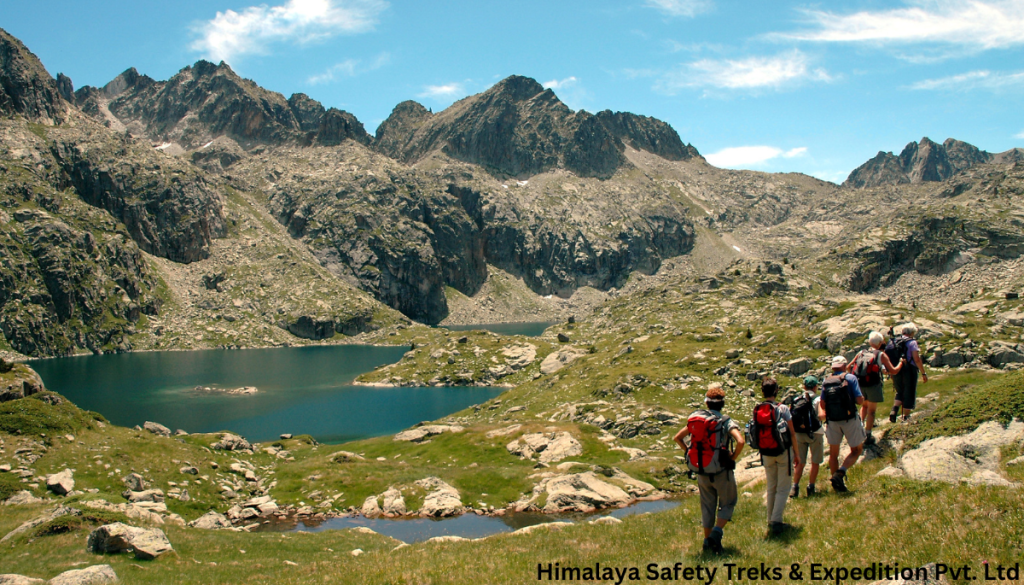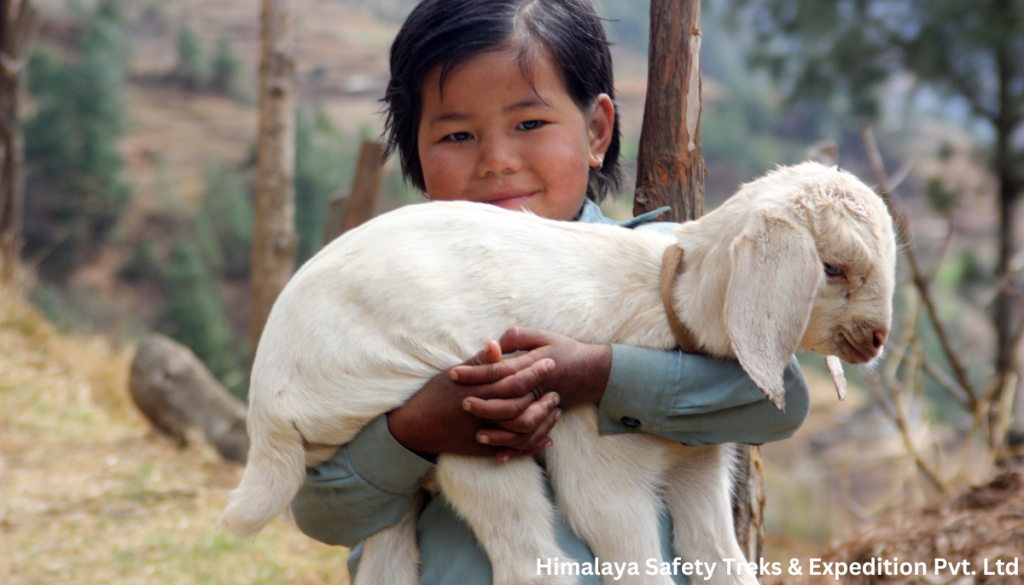A professional trekking guide is a government-authorized expert who leads tours through the hills and mountains. Hiring a trekking guide in Nepal is now mandatory for those exploring the Himalayas. These guides are knowledgeable about trekking trails, local cultures, accommodations, permits, safety measures, viewpoints, and more. Having a trekking guide benefits both trekkers and the socio-cultural fabric of the nation.
Himalaya Safety Treks & Expedition Pvt. Ltd. is here to provide you with a professional trekking guide for your next adventure in Nepal. We offer the best trekking packages with top-notch services in the Himalayas. Our guides are government-licensed and experts in each trekking region of Nepal. With over two decades of experience, we provide well-experienced, multi-lingual (Korean and English), certified, and skilled trekking guides. Contact us for any travel or trekking services in Nepal.
Table of Contents
11 Reasons to Hire a Trekking Guide During Your Journey
1. Safety and Security
Trekking at high altitudes carries inherent risks, such as altitude sickness and unpredictable weather conditions. A professional trekking guide is trained to recognize the symptoms of altitude sickness and can take immediate action to prevent it from worsening. They also have knowledge of the terrain and can navigate through challenging weather conditions, ensuring your safety at all times. If an emergency arises, such as an injury or severe altitude sickness, a guide can quickly arrange for medical assistance or helicopter rescue, providing peace of mind during your trek. Additionally, guides carry essential safety gear and first aid kits, and they are trained in emergency response, making them invaluable during critical situations.

Epic 5 Days Panchase Trek: Full Guide
2. Proper Navigation of the Trail
While some trekking routes in Nepal are well-marked, many trails are not. Navigating through unpaved roads, narrow trails, and remote settlements can be confusing, especially for first-time trekkers. An experienced trekking guide knows the routes like the back of their hand and can lead you safely through the most challenging sections. They can also take you to lesser-known viewpoints and hidden gems that you might miss if trekking alone. Moreover, guides are familiar with seasonal changes and can adapt the trekking plan accordingly, ensuring you avoid areas prone to landslides or other hazards during certain times of the year.
3. Promote the Local Economy
The tourism industry is vital to Nepal’s local economy. Hiring a local guide supports the community by providing employment opportunities and promoting local businesses. Guides often recommend local teahouses, restaurants, and shops, helping to increase the revenue of the area. This economic boost improves the living standards of local families and contributes to the overall development of the region. Your small contribution by hiring a trekking guide can have a significant positive impact on the community. Additionally, guides often collaborate with local artisans and craftsmen, promoting their handmade goods and traditional products, further supporting the local economy.

Makalu Base Camp Trek: An 18-Day Himalayan Adventure
4. Local Cultural Experience
Nepal is home to a rich tapestry of cultures, each with its unique traditions, languages, and lifestyles. A professional trekking guide can provide insights into the local customs and practices, enhancing your cultural experience. They can explain the significance of various rituals, festivals, and historical sites, giving you a deeper understanding of the region. By interacting with locals through your guide, you can gain a more authentic and enriching experience, something that solo trekking may not offer. Furthermore, guides can introduce you to local cuisines, helping you discover traditional dishes and flavors that you might otherwise miss.
Exploring Bardiya National Park: Nepal’s Untamed Wilderness
5. Provides Hidden Views of the Himalayas
To truly appreciate the majesty of the Himalayas, you need to be in the right place at the right time. A trekking guide knows the best spots for breathtaking views and can take you there. Whether it’s a sunrise over the Annapurna range or a secluded viewpoint of Mount Everest, a guide ensures you don’t miss these spectacular sights. These hidden views can become some of the most cherished memories of your trek. Additionally, guides can suggest the best times for photography, ensuring you capture stunning images of the landscape.

6. Quality Logistic Facilities
Managing logistics such as accommodation, meals, and transportation can be challenging, especially during peak trekking seasons. A trekking guide has established relationships with local teahouses and hotels, ensuring you get the best possible accommodations at reasonable prices. They can also arrange transportation, helping you avoid overpaying for private vehicles. With a guide, you can focus on enjoying your trek without worrying about logistical details. Moreover, guides can handle permit arrangements and other administrative tasks, streamlining the process and saving you time and effort.
Top 5 One-Day Short Treks Near Pokhara
7. Motivation
Trekking in the Himalayas is physically and mentally demanding. There will be times when you feel exhausted and may want to give up. A trekking guide provides the motivation and encouragement needed to keep going. They offer moral support, share inspiring stories, and even help carry your load if necessary. Their experience and positive attitude can make a significant difference in your ability to complete the trek. Additionally, guides can help you set realistic goals and pace yourself, ensuring you do not overexert and can enjoy the journey.
8. Assist You with the Local Language Barrier
Language can be a significant barrier when trekking in remote areas of Nepal. Many locals speak little or no English, making communication difficult. A trekking guide acts as a translator, helping you interact with local people, understand their needs, and navigate any challenges that arise. They can also teach you basic Nepali phrases, making your interactions more meaningful and enjoyable. Furthermore, guides can facilitate cultural exchanges, helping you learn more about local customs and traditions through direct conversations with residents.

9. Provides Environmental Awareness
Preserving the natural beauty of the Himalayas is crucial for sustainable tourism. A trekking guide educates you on responsible trekking practices, such as minimizing waste, respecting wildlife, and supporting eco-friendly businesses. They ensure that you leave no trace and help maintain a pristine environment for future generations. By following their guidance, you contribute to the conservation of Nepal’s natural heritage. Guides also often participate in and promote local conservation efforts, such as trail clean-up initiatives and reforestation projects.
Rara Lake: A Travel Guide for 2024
10. A Friend for a Lifetime
Trekking with a guide is not just about following a route; it’s about building a relationship. Spending days together in the mountains creates a unique bond, and your guide often becomes a lifelong friend. They share their knowledge, stories, and culture, making your trek a memorable and personal experience. Many trekkers stay in touch with their guides long after the trek, cherishing the friendship formed during the journey. This connection often leads to future treks together, further deepening the friendship.

11. Provide You with Mountain Rules and Regulations
Each trekking region in Nepal has specific rules and regulations that must be followed. A trekking guide is well-versed in these rules and ensures you comply with them. They inform you about cultural norms, such as prohibitions on eating meat in certain areas or restricted zones where entry is not allowed. This knowledge helps you avoid unintentional violations and ensures a respectful and lawful trekking experience. Additionally, guides can provide insights into local environmental laws and practices, helping you trek responsibly and sustainably.
Everest Base Camp Trek in 2024
How to Choose the Best Trekking Guide
Selecting the right trekking guide is crucial for a successful trek. Here are some tips to help you choose the best guide:
Qualifications
Ensure the guide is well-trained in various sectors, such as first aid, environmental conservation, local culture, and crisis management. A qualified guide is equipped to handle any situation that may arise during the trek. Look for certifications from recognized training programs and associations.

Experience
Ask about the guide’s experience in the trekking industry. A guide with years of experience in the specific region you plan to trek will have invaluable knowledge and insights. Experienced guides are familiar with the terrain, weather patterns, and potential challenges of the trek.
Communication Skills
Meet with the guide beforehand to assess their communication skills. Effective communication is essential for a smooth and enjoyable trek. Ensure that the guide can clearly explain the itinerary, safety measures, and any other important information.
Reviews and Recommendations
Check social media, online forums, and travel websites for reviews and recommendations. Positive feedback from previous trekkers is a good indicator of a reliable guide. Look for detailed reviews that highlight the guide’s strengths and any potential areas of concern.
Certification and Licensing
Verify that the guide has the necessary certifications and a government-issued license. This ensures they meet the required standards and are legally allowed to operate. A licensed guide is more likely to adhere to professional and ethical standards.
Conclusion
Hiring a trekking guide is essential for a safe and enjoyable trekking journey. They provide more than just directions—they are friends, rescuers, and communicators. For a secure and memorable trekking experience, hire a professional guide from Himalaya Safety Treks & Expedition Pvt. Ltd.

FAQs on Hiring a Trekking Guide in Nepal
What is the cost of a trekking guide per day in Nepal?
The cost ranges from $25-$35 per day, depending on the guide’s experience and the region.
Is hiring a trekking guide in Nepal mandatory?
As of April 1, 2023, hiring a guide is mandatory for all trekkers in Nepal.
How do I identify a government-licensed trekking guide in Nepal?
Before hiring a trekking guide, ask to see their license and inquire about their experience.
Is it safe for female trekkers to hire a trekking guide?
Yes, it is safe. Female trekkers can also request female guides for added comfort and security.
How much should I tip a trekking guide?
Tips depend on the service quality. A standard tip ranges from 10-20% of the total cost, but you can adjust based on your satisfaction.
Can I hire a guide from the local area during the trek?
While it is possible to hire a guide locally, it is recommended to hire a government-licensed guide through a reputable agency for safety and reliability.













